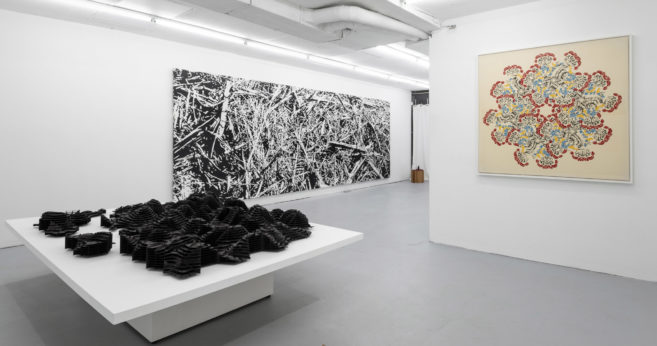Bruce Cockburn sang that the skin around every city looks the same. One could say the same about any large city centre, with their deep concrete and glass canyons. For much of the latter half of the 20th century, such uncompromising spaces were the stage for monumental abstract sculpture, one of High Modernism’s last flourishes. While the architectural scale of this work, its insistent self-referentiality and eschewing of any content beyond its form can seem dated, and lacking in contemporary relevance, the best of this work often adds a welcome point of stability in rapidly changing urban environments. Robert Murray, who moved from Saskatchewan to New York in 1960, where he achieved renown, makes such sculptural work. He engages architecture directly, using monumentality to achieve an autonomous presence in environments where any works, regardless of scale, will be dwarfed by the constructions around them.
Murray’s new exhibition in Halifax, “Models, Paintings and Sculpture,” features recent work, much of it completed in the last three years. A series of models sit on plinths and range in scale from about 10 to 20 inches in height. Mostly painted in bright primary colours, these small works have an outsized presence. An accompanying group of watercolours revisits the theme of blue columns (as seen in two of the models in the show) and illustrates how Murray thinks through his forms before making them in three dimensions. The sole stand-alone sculpture in the exhibition, Enigma (2016), is made from aluminum and painted a bright red. Standing just over five feet tall, Enigma fills the space as a figure would, and features on one side a sinuous curve, an “s” shape that defies explanation until one walks around the sculpture and sees the weld marks form where two plates were joined.
“Models, Paintings and Sculpture” is a quiet exhibition, unapologetically Modernist in its approach, and its cerebral formalism is refreshing. Modernism didn’t succeed in making a new world, but, when well executed, a Modernist like Murray can still make objects that evoke such a thing, and that achieve a clarity and sureness that is somehow comforting.

Robert Murray, Blue Columns, 2017. Painted-steel maquette, 41.2 x 15.8 x 14.6 and 54.2 x 10.1 cm. Photo: Grace Laemmler.

Robert Murray, Blue Arch, 2018. Painted-aluminum maquette, 41.9 x 8.8 x 35.5 cm. Photo: Grace Laemmler.

Installation view (detail) of Robert Murray's “Models, Paintings and Sculpture” at Studio 21 Fine Art.

 Robert Murray, Tlingit, 2016. Painted-steel maquette, 26.6 x 21.5 x 39.3 cm. Photo: Grace Laemmler.
Robert Murray, Tlingit, 2016. Painted-steel maquette, 26.6 x 21.5 x 39.3 cm. Photo: Grace Laemmler.







